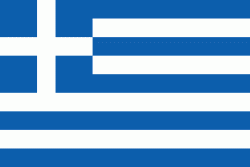Santorini (Santorini Airport)
Santorini (Thira) International Airport (Κρατικός Αερολιμένας Σαντορίνης) is an airport in Santorini/Thira, Greece located north of the village of Kamari. The airport serves as both a military and a civil airport. With its redesigned apron, as of 2021 the airport is able to serve up to nine civilian airliners at the same time. Santorini is one of the few Cyclades Islands with a major airport.
The airport is located about 6 km southeast of the centre of the city of Thira. The main asphalt runway (17/35) is 7,208 ft in length. The parallel taxiway was built and marked to runway specification but is now marked and lighted as a taxiway. The airfield can accommodate medium-sized jets like the Boeing 757, Boeing 737 and Airbus 320 series as well as smaller aircraft such as the Avro RJ, Fokker 70, and ATR 72. Scheduled airlines include Ryanair, Olympic Air and Aegean Airlines, with seasonal scheduled and charter flights from other airlines during the higher seasons in spring, summer and autumn. Transportation to and from the air terminal is via buses, taxis, hotel car-pickups and hired cars.
The airport first operated in 1972.
In December 2015 the privatisation of Santorini (Thira) International Airport and 13 other regional airports of Greece was finalised with the signing of the agreement between the Fraport AG/Copelouzos Group joint venture and the state privatisation fund. According to the agreement, the joint venture will operate the 14 airports (including Santorini (Thira) International Airport) for 40 years as of 11 April 2017. In 2016 the airport was voted as one of the worst airports, the commentary mentions the situation in summer where travelers can wait for hours under the hot sun while inside they are crammed into small rooms without air conditioning.
The airport is located about 6 km southeast of the centre of the city of Thira. The main asphalt runway (17/35) is 7,208 ft in length. The parallel taxiway was built and marked to runway specification but is now marked and lighted as a taxiway. The airfield can accommodate medium-sized jets like the Boeing 757, Boeing 737 and Airbus 320 series as well as smaller aircraft such as the Avro RJ, Fokker 70, and ATR 72. Scheduled airlines include Ryanair, Olympic Air and Aegean Airlines, with seasonal scheduled and charter flights from other airlines during the higher seasons in spring, summer and autumn. Transportation to and from the air terminal is via buses, taxis, hotel car-pickups and hired cars.
The airport first operated in 1972.
In December 2015 the privatisation of Santorini (Thira) International Airport and 13 other regional airports of Greece was finalised with the signing of the agreement between the Fraport AG/Copelouzos Group joint venture and the state privatisation fund. According to the agreement, the joint venture will operate the 14 airports (including Santorini (Thira) International Airport) for 40 years as of 11 April 2017. In 2016 the airport was voted as one of the worst airports, the commentary mentions the situation in summer where travelers can wait for hours under the hot sun while inside they are crammed into small rooms without air conditioning.
Map - Santorini (Santorini Airport)
Map
Country - Greece
 |
 |
| Flag of Greece | |
Greece is considered the cradle of Western civilization, being the birthplace of democracy, Western philosophy, Western literature, historiography, political science, major scientific and mathematical principles, theatre and the Olympic Games. From the eighth century BC, the Greeks were organised into various independent city-states, known as poleis (singular polis), which spanned the Mediterranean and the Black Sea. Philip II of Macedon united most of present-day Greece in the fourth century BC, with his son Alexander the Great rapidly conquering much of the ancient world, from the eastern Mediterranean to the North Western parts of India. The subsequent Hellenistic period saw the height of Greek culture and influence in antiquity. Greece was annexed by Rome in the second century BC, becoming an integral part of the Roman Empire and its continuation, the Byzantine Empire, which was culturally and linguistically predominantly Greek.
Currency / Language
| ISO | Currency | Symbol | Significant figures |
|---|---|---|---|
| EUR | Euro | € | 2 |
| ISO | Language |
|---|---|
| EN | English language |
| FR | French language |
| EL | Greek language |















